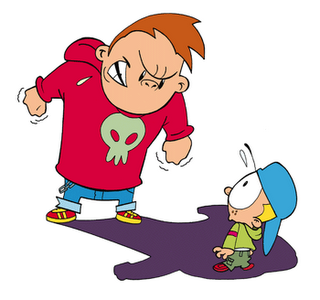Sticks and stones and breaking bones: Social psychology and school aggression
 https://www.flickr.com/photos/pimkie_fotos/
https://www.flickr.com/photos/pimkie_fotos/
Throughout the years in which aggression in schools has been researched, one interesting finding has been replicated many times over. That is, that when you ask children ‘what do you think of bullying?', they will reply that it is wrong (e.g., Brown, Birch, & Kancheria, 2005). Yet, statistics on bullying show that 30% of children may be the target of it at some point in time (Analitis et al., 2009). In a striking study by Atlas and Pepler (1998), it was revealed that peers were present in 85% of all bullying episodes on a school playground, yet, they intervened to stop the bullying instances just 15% of the time. Why is this? Why do children act so differently versus the way that they think and feel when it comes to bullying?
This is one of two blog posts that will look at school aggression from the perspective of contemporary social psychology. Although, as a discipline, social psychology has studied groups for decades, it has been less than ten years since this research expertise was applied to the playground. Since then it has been shown that group processes may help us to understand children's bullying tendencies. In this post, I'll examine the perspective from the point of view of those who bully: in my next post, I'll look at the perspective of the bullied victims. When it comes to the social psychology of aggression in schools, it seems that groups can both be a part of the problem and the solution.
Children's Group Norms
Developmental psychology has taught us that belonging matters to children from a very young age. In one study, Over and Carpenter (2009) showed that from five years old children are sensitive to the pain of being left out of a game, and seek contact with others when they feel left out. Much like adults, children show a strong bias towards their own friendship group when they are asked to allocate rewards between that and another group. A good example of this is a study by Bigler, Jones, and Lobliner (1997). These researchers gave children at a summer school two different colored t-shirts to wear. In experimental groups, use of the colored t-shirts was made in activities, and children then attributed many more positive characteristics to their own colored-t-shirt group than to the other group.
That's all very well, but what about school aggression and bullying? Gini (2007) revealed that children who were randomly assigned to a bullying group, or a victim group, before reading about an intergroup bullying incident attributed more blame for the bullying incident to the group that they didn't belong to (even if this was the group on the receiving end of the bullying). More than this, research has shown that group-based pride in a bullying incident increased with an increasing sense of belonging to a bullying group (Jones, Manstead, & Livingstone, 2009).
Playing By the Rules
The research findings above are in line with a framework called Social Identity Theory (Tajfel & Turner, 1979), which says that group members are driven to act on behalf of their group's good name. An element of the social identity approach is that group members are motivated to stick to a set of rules – norms-that define the group’s attitudes and behavior, and positively distinguish the group from other groups (e.g., Turner, 1999).
There is evidence to strongly suggest that even young children are sensitive to rules of the groups they belong to. For example, Nesdale, Durkin, Maass, Kiesner, and Griffiths (2008) showed that children’s intentions to aggress were enhanced by a group norm for dislike for other groups, relative to another-group liking norm. Moreover, it has been shown that among children who belong to a group with a pro-bullying norm, those who bully others gain status and power within that group (Roland & Idsøe, 2001). Thus, children are more likely to bully others if they belong to a group with a culture of bullying.
Researchers have shown that group beliefs, whether they are held at the classroom or peer group level, about the acceptability of aggression influence the amount of aggression they display. Sentse, Scholte, Salmivalli, and Voeten (2007) showed that children who bullied were more likely to be rejected by their peers in a class where bullying was unusual, but less likely to be rejected by their peers where bullying was a class norm. Espelage, Holt, and Henkel (2003) identified peer groups of middle school children, and followed them for a year. They found that members of peer groups that engaged in bullying increased their own bullying behaviors over time. It is possible that peer groups similarly have norms concerning bullying, and group members are rewarded for sticking to these rules - meaning that children might be motivated to bully, even if they feel it is wrong, for the sake of belonging to the group.
Conclusions
From a young age children have to learn to navigate a complex social world. They quickly learn about the rules of the groups they belong to, and about who is ‘in’ and who is ‘out’. Children have a sense of belonging within their peer groups, which is a basis for high self-esteem. However, working within the frame of Social Identity Theory, research suggests that the elements that allow children’s peer groups to work together harmoniously can also lead to bullying, where peer group rules, (norms) condone it. And the more a child is involved with their peer group (and wants to belong to it), the more likely they are to stick to group norms - and by consequence to bully others - even if their individually-held views would never justify bullying.
References:
Analitis, F., Velderman, M. K., Ravens-Sieberer, U., Detmar, S., Erhart, M., Herdman, M., Berra, S., Alonso, J., & Rajmil, L. (2009). Being bullied: Associated factors in children and adolescents 8-18 years old in 11 European countries. Paediatrics, 123, 569-577. doi: 10.1542/peds.20080323
Atlas, R. S., & Pepler, D. J. (1998). Observations of bullying in the classroom. Journal of Educational Research, 92, 86–89. doi:10.1177/0143034300 211002
Bigler, R.S., Jones, L.C., & Lobliner, D.B. (1997). Social categorization and the formation of intergroup attitudes in children. Child Development, 68, 530543. doi: 10.1037/a0022459
Brown, S., Birch, D., & Kancheria, V. (2005). Bullying perspectives: Experiences, attitudes, and recommendations of 9- to 13-year-olds attending health education centers in the United States. Journal of School Health, 75, 384-392. doi: 10.1111/j.1746- 1561.2005.00053.x
Espelage, D., Holt, M., & Henkel, R. (2003). Examination of peer-group contextual effects on aggression during early adolescence. Child Development, 74, 205–220. doi: 10.1111/1467-8624.00531
Gini, G. (2007). Who is blameworthy? Social identity and inter-group bullying. School Psychology International, 28, 77–89. doi:10.1177/0143034307075 682
Jones, S. E., Manstead, A. S. R., & Livingstone, A. (2009). Birds of a feather bully together: Group processes and children’s responses to bullying. British Journal of Developmental Psychology, 27, 853–873. doi:10.1348/02615 1008X390267
Nesdale, D., Durkin, K., Maass, A., Kiesner, J., & Griffiths, J. (2008). Effects of group norms on children's intentions to bully. Social Development, 17, 889–907. doi: 10.1111/j.1467-9507.2008.00475.x
Over, H., & Carpenter, M. (2009). Priming third-party ostracism increases affiliative imitation in children. Developmental Science, 12 (3), F1-F8.
Roland, E., & Idsøe, T. (2001). Aggression and bullying. Aggressive Behavior, 27, 446-462. doi: 10.1002/ab.1029
Sentse, M., Scholte, R., Salmivalli, C., & Voeten, M. (2007). Person-group dissimilarity in involvement in bullying and its relation with social status. Journal of Abnormal Child Psychology, 35, 1009–1019. doi:10.1007/s108 02-007-9150-3
Tajfel, H., & Turner, J. (1979). An integrative theory of intergroup conflict. In W.G. Austin & S. Worchel (Eds.) The social psychology of intergroup relations. (pp. 7-24). Monterey, CA: Brooks Cole.
Turner, J. C. (1999). Some current issues in research on social identity and self- categorization theories. In N. Ellemers, R. Spears, & B. Doosje (Eds.) Social identity: Context, commitment, content. (pp. 6-34). Oxford: Blackwell.

